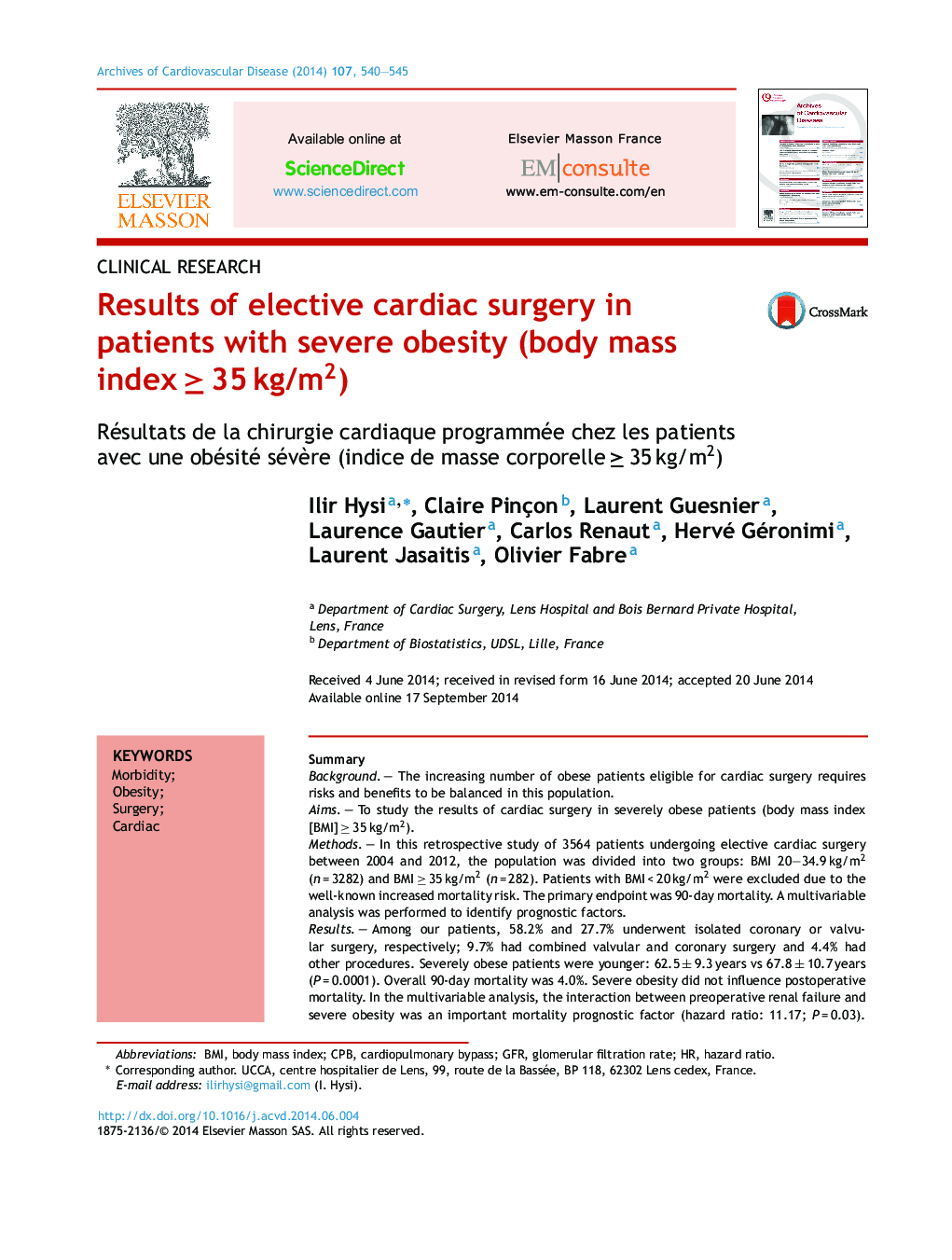| کد مقاله | کد نشریه | سال انتشار | مقاله انگلیسی | نسخه تمام متن |
|---|---|---|---|---|
| 2888970 | 1574351 | 2014 | 6 صفحه PDF | دانلود رایگان |

SummaryBackgroundThe increasing number of obese patients eligible for cardiac surgery requires risks and benefits to be balanced in this population.AimsTo study the results of cardiac surgery in severely obese patients (body mass index [BMI] ≥ 35 kg/m2).MethodsIn this retrospective study of 3564 patients undergoing elective cardiac surgery between 2004 and 2012, the population was divided into two groups: BMI 20–34.9 kg/m2 (n = 3282) and BMI ≥ 35 kg/m2 (n = 282). Patients with BMI < 20 kg/m2 were excluded due to the well-known increased mortality risk. The primary endpoint was 90-day mortality. A multivariable analysis was performed to identify prognostic factors.ResultsAmong our patients, 58.2% and 27.7% underwent isolated coronary or valvular surgery, respectively; 9.7% had combined valvular and coronary surgery and 4.4% had other procedures. Severely obese patients were younger: 62.5 ± 9.3 years vs 67.8 ± 10.7 years (P = 0.0001). Overall 90-day mortality was 4.0%. Severe obesity did not influence postoperative mortality. In the multivariable analysis, the interaction between preoperative renal failure and severe obesity was an important mortality prognostic factor (hazard ratio: 11.17; P = 0.03). Mediastinitis rates were similar between groups in non-diabetic patients; in diabetic patients, severe obesity was associated with higher mediastinitis rates (P = 0.002). Superficial wound infections were higher in severely obese patients (P = 0.003).ConclusionElective cardiac surgery in severely obese patients was not associated with increased perioperative morbimortality, but had a higher superficial wound infection risk. Nevertheless, severe obesity itself should not be a contraindication to elective surgery.
RésuméContexteL’augmentation des patients obèses éligibles à la chirurgie cardiaque nécessite de mieux étudier la balance bénéfices–risques.ObjectifÉtudier les résultats de la chirurgie programmée chez les patients obèses sévères (indice de masse corporelle [IMC] ≥ 35 kg/m2).MéthodesIl s’agit d’une étude rétrospective de 3564 patients opérés entre 2004 et 2012. La population a été divisée en deux groupes : IMC : 20–34,9 kg/m2 (n = 3282) et IMC ≥ 35 kg/m2 (n = 282). Les patients avec un IMC < 20 kg/m2 ont été exclus en raison d’un surrisque bien établi dans la littérature. Le critère de jugement était la mortalité à 90 jours.RésultatsRespectivement, 58,2 % et 27,7 % des patients ont eu une chirurgie coronarienne ou valvulaire ; 9,7 % une chirurgie combinée et 4,4 % d’autres procédures. Les patients obèses sévères étaient plus jeunes : 62,5 ± 9,3 ans vs 67,8 ± 10,7 ans (p = 0,0001). La mortalité à 90 jours était de 4,0 % et non influencée par l’obésité sévère. L’association insuffisance rénale préopératoire et obésité sévère était de mauvais pronostic (HR : 11,169 ; p = 0,03). Les taux de médiastinite étaient comparables entre les groupes, chez les non-diabétiques, alors que chez les diabétiques l’obésité sévère était associée à plus de médiastinites (p = 0,002). Les infections des cicatrices étaient plus élevées chez les patients obèses sévères (p = 0,003).ConclusionsLa chirurgie cardiaque programmée chez des patients obèses sévères n’accroît pas la morbi-mortalité périopératoire. Elle présente un risque plus élevé d’infection de la cicatrice. Néanmoins, l’obésité sévère en soi ne devrait pas être une contre-indication à cette chirurgie.
Journal: Archives of Cardiovascular Diseases - Volume 107, Issue 10, October 2014, Pages 540–545